How the right outdoor lighting can transform your garden
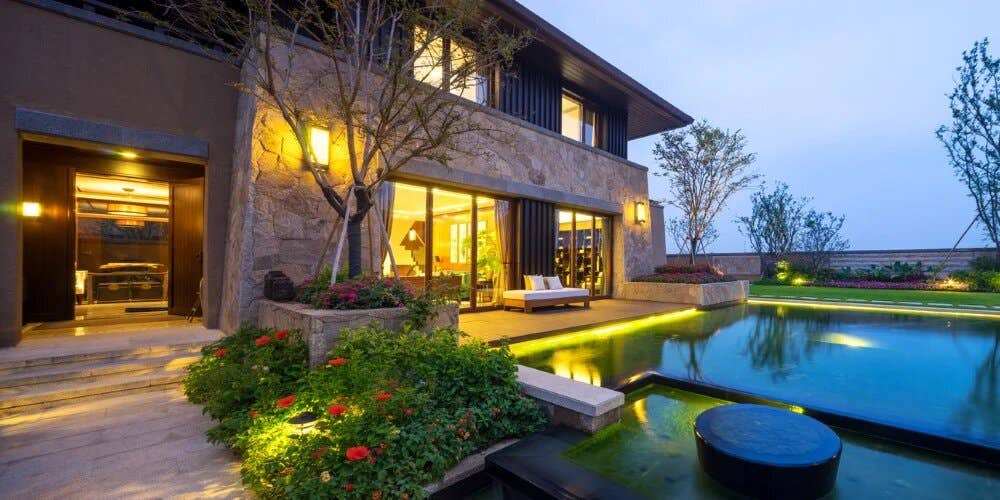
The correct garden lighting can make a huge difference to even the smallest of gardens, especially during the winter months when daylight hours are shorter and colour and foliage is sparse.
Here we will look at different ways to illuminate your outside space for year-round appeal, and help ensure that you are selecting the correct lamps for the intended purpose.
In this guide you will find out:
- Expert advice on lighting your garden
- How to choose lighting according to the size and style of your garden
- Types of outdoor lighting
- Where to position garden lighting
- Top tips on lighting your garden on a budget
- How to power your garden lighting
- Choosing the right colour temperature for your garden lamps
- Things to avoid when choosing outdoor lighting
- Tips for lighting your garden during the winter months
To find out more about effective and innovative ways to light your garden we enlisted the help of a range of experts:
Expert advice on lighting your garden |
|---|
The lighting expert’s view:Arthur Smith: When it comes to integrating lighting into your garden and patio, I'd recommend solar lights as they are one of the most cost-effective lighting options. For non-solar lighting, the possibilities are endless. Simple string lights or globe lights can add a nice fairytale feel to your outdoor space, they will also work great as Christmas lighting. Fence lights and deck step lights will help illuminate the perimeter of your backyard or any steps, and path lights are still the go-to option for illuminating the driveway. |
The garden designer’s view:Jane Hicks: Directional and safety lighting on paths and steps is the most important aspect of garden lighting. Outdoor lighting is also great for defining an area, such as the house and patio, and for highlighting interesting aspects such as a water feature or sculpture. When it comes to creating an impact, less is more: soft, low level and careful placement. |
The architect’s view:Steve Reading: Lighting can be used to accentuate sight lines and wash lighting with a hidden source can look very effective on stone walls. Uplighters in trees can also be successful if used subtly. |
The interior designer’s view:Gilly Craft: The outdoor lighting plan should be thought about from the moment the garden design is first considered. It is no different from when designing an interior scheme, the lighting plan is an integral part of the overall look. |
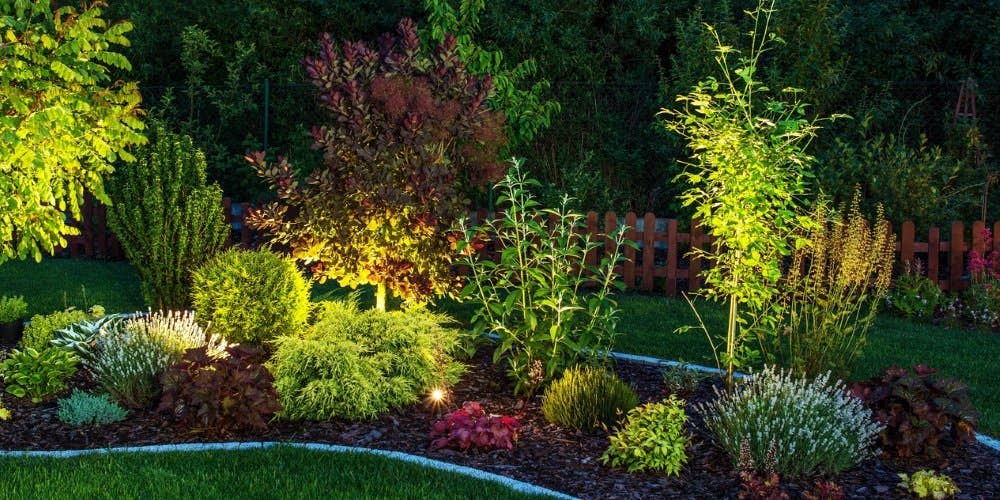
Top tip: When choosing your garden lighting, be sure to plan out your lighting set-up beforehand and do your research. This is the only fool-proof way for you to ensure that the lighting you chose will be suitable for your particular outdoor space. Arthur Smith
Choosing lighting to suit the size and style of your garden |
|
|---|---|
|
Large gardens |
Jane Hicks: Highlight mature trees by either placing a spotlight at the base of the trunk and using uplighting to illuminate the branches and canopy, or positioning the light fixture high up inside the tree and directing the light downwards towards the ground (moonlighting). This can also be used on smaller plants, such as architectural shrubs and perennials, throughout the garden. Arthur Smith: For a larger gardens I love in-ground lights. They look classic, especially when strategically spaced throughout the garden. |
|
Smaller gardens or patios |
Jane Hicks: An ambient lighting scheme can make your garden look bigger. Incorporate soft recessed uplights around the perimeter of a deck, paving slabs or along each side of pathways—this will also be helpful for directional purposes. String lights suspended beneath a pergola, tree or shrub can also be effective. Arthur Smith: Gardens that are on the smaller side will benefit from any type of lights since lighting will brighten up the garden and make it look bigger, especially when it's dark outside. I particularly love smaller, daintier garden lights for smaller properties as they won't overpower the space with both their presence or the amount of light they emit. Gilly Craft: In my experience, a lighting scheme is no different in a large garden to a small garden. Certain features—such as plants, trees, planters and paths—should all be illuminated in some way. |
|
Contemporary gardens |
Jane Hicks: Spike lights are easy to push into the soil of your bedding area to offer directional lighting, and will subtly highlight architectural plants and trees, stems and foliage. If plants are adjacent to walls, well positioned lighting can create stunning silhouettes (shading). Chic strip lights set beneath the edge of the tread of garden steps and beneath built in benches can also be used to define different areas of a garden. Arthur Smith: Contemporary spaces are usually more modern and hip than your average area and therefore will benefit from lighting of a similar style. Uniquely shaped chandeliers, sleek track lighting fixtures and panel lights always look great with contemporary decor. Steve Reading: Feature lighting and lamps can successfully underline clean, sharp lines and edges in contemporary solutions. Gilly Craft: If the garden/house is of a sleek, contemporary design, then the style of the light fittings should reflect this. The same goes for a traditional garden. |
|
Traditional/cottage gardens |
Jane Hicks: Spot lighting can be used effectively to highlight garden sculptures, although careful consideration is needed to suit the type of fixture and also the direction in which it is illuminated. Arthur Smith: When I think of cottage gardens, I automatically think of a more romantic approach to lighting. Things like string lighting and lantern lights that emit warm, yellow-white light would work well in a more traditional garden. Steve Reading: I would recommend using low-level solar-powered lamps to create a gentle lighting effect. |
Types of outdoor lighting |
|---|

Floodlights Floodlights are used for illuminating large areas, often combined with a motion detector (PIR) for security purposes. Arthur Smith: Floodlights are great for creating an impact. They are a truly powerful lighting option that provide a lot of light and are very durable. |

Coloured spotlights Coloured (red, blue, yellow) garden spotlights—known as PAR 38CFLs—can also be used indoors for creating special effects in bars and clubs. |
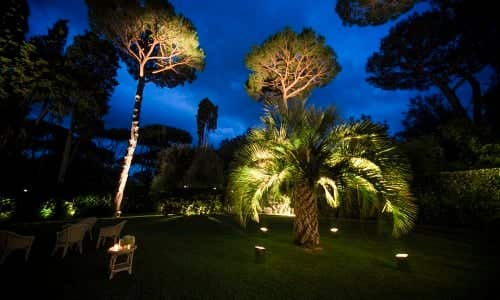
White garden spotlights Also used for spotlights in theatrical settings, PAR 64 lamps create a sharp beam ideal for highlighting features. Jane Hicks: Uplighting or moonlighting trees and distinctive plants can create a dramatic effect, especially during the winter months. |
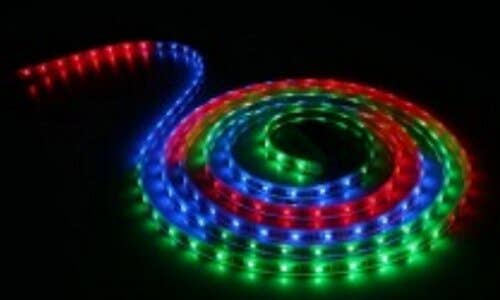
Ribbon strip lighting Ribbon lighting is a waterproof lighting solution which can simply be cut to size and attached to your outdoor fixtures using its adhesive backing. Available in a variety of colours, a strip light ribbon can be remotely operated to activate different colours and sequences. A waterproof LED driver is required to operate a ribbon strip light. Jane Hicks: If the garden has a pond, underwater lighting will highlight ripples and textures. |
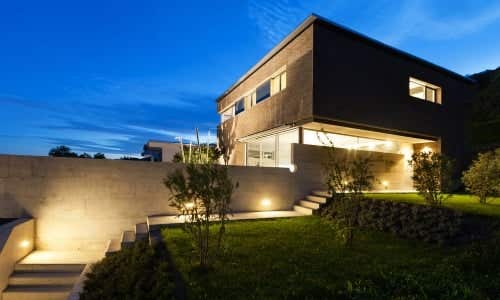
Bulkhead lamps Heavy duty, industrial-style Bulkhead lamps are commonly used to illuminate stairwells. |
|
CFL Square lamps High-efficiency lamps are often used for indoor gardening purposes but can also be used outdoors with suitably designed luminaires. |
Positioning your garden lights
Garden lights can provide effective lighting for both security, decorative and practical outdoor lighting. They can be positioned in numerous locations around your outside space, including:
- Wall mounted on the home or outbuildings
- Recessed into the lawn
- Recessed into decking
- Recessed into bricks or steps
- In borders or grass using spike lights
- In water features or hot tubs
- On posts lining a walkway
- Along trees, awnings or pergolas using string lights

Advice from the experts on lighting your garden on a budget |
|---|
|
Jane Hicks: Plug and play lights can be particularly budget-friendly as there's no need for an electrician. Simple fairy lights threaded through a tree or over an arch are an even cheaper option—they can be solar powered so no need for a power supply. Arthur Smith: Lighting a garden or patio on a budget can be challenging, but it's not impossible. Since outdoors spaces usually require more lights than the inside of your home, buying in bulk will let you save some money and will allow you to fill your backyard with the necessary amount of light for it to look great. Solar lights—even if you invest in high quality models—will soon pay for themselves due the amount of energy they save. LED bulbs are great for those on a budget but who don't want to use solar lights, since they use much less energy and therefore your electricity bill will be considerably lower. Steve Reading: Solar-powered lighting can be a much cheaper option as is avoids any cable laying costs. Gilly Craft: There are some very good solar lights that can be used that don’t require wiring. |
Top tip: My three main tips are to invest in good solar lights, buy in bulk and use LED bulbs. Arthur Smith
Powering your garden lighting
Garden lighting is powered in one of three ways: mains operated, battery operated or solar powered. Here are the pros and cons of each method.
Power source |
Pros |
Cons |
|---|---|---|
|
Mains operated |
|
|
|
Battery operated |
|
|
|
Solar operated |
|
|
Choosing the right colour temperature for your garden lamps
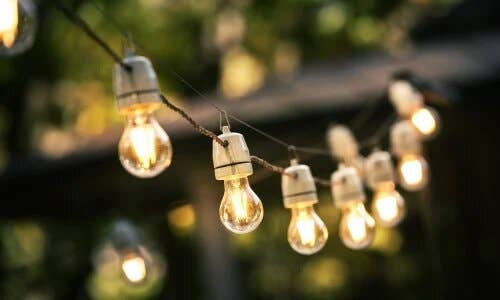
Warm (yellow)
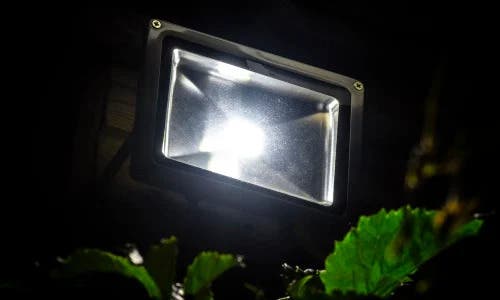
Cool (white/blue) light
- Light colour (colour temperature) is measured in Kelvins (K)—the lower the number of Kelvins the warmer (or yellower) the light will be.
- Lamps with a higher number of kelvins will be a cooler white, closer to natural daylight.
- Lamps with colour temperatures between 2,700–3,000K are considered ‘warm’ whites.
- Lamps with colour temperatures of 5,000K or above are considered ‘cool’ whites.
Expert advice on outdoor lighting to avoid |
|---|
|
Jane Hicks: I would avoid cold colours such as blue or bright white, think how the fixtures will look during the day—no point having to look at an unattractive light fitting during the day! Arthur Smith: As a rule of thumb, warmer lighting colours work better as outdoor lighting. It just looks more natural and less creepy. So I'd say for outdoors lighting avoid blue-white lighting and go for light bulbs that are more yellow in tone. Steve Reading: Harsh whites and primary colours should be avoided. |
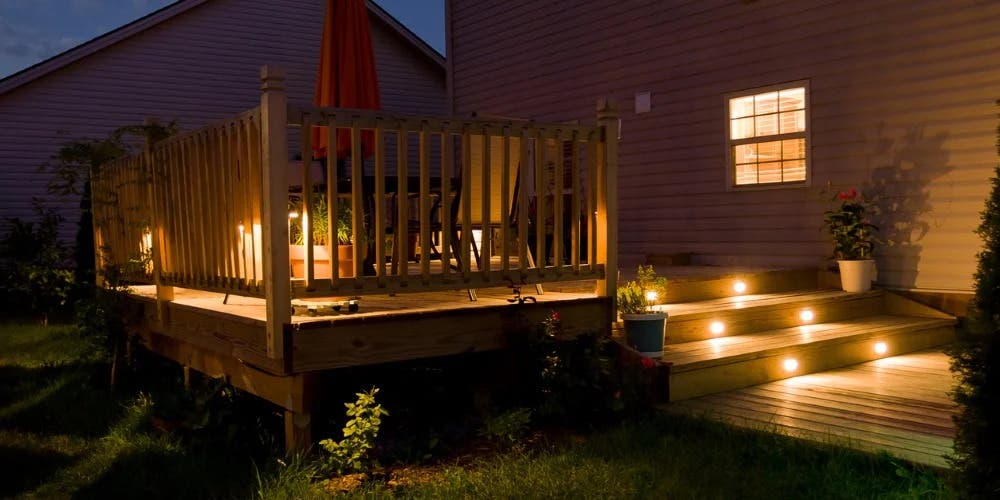
6 tips for lighting your garden during the winter months
Lighting can be used to create an impact during the winter months when colour and foliage are reduced. Here’s how:
- Recessed uplights set into the edge of a deck or patio can distract from lack of foliage. Jane Hicks
- Use colourful spotlights to brighten and liven up a fountain or water feature. Arthur Smith
- Create a feature of the skeleton of a large tree with uplighting or moonlighting. Jane Hicks
- Highlight topiary with strings of fairy lights. Jane Hicks
- Trees and evergreen borders can be illuminated in the winter to great effect Gilly Craft
- Directing a floodlight at a distinctive tree or interesting structure can make your outdoor area look truly unique. Arthur Smith



